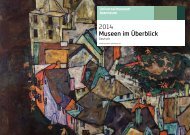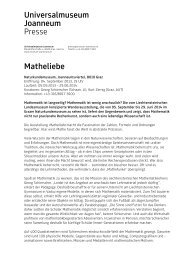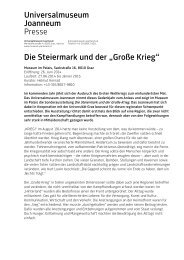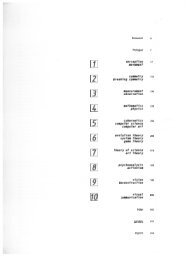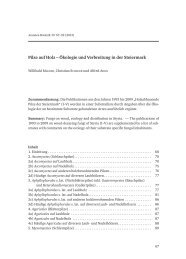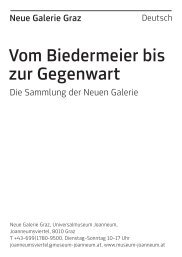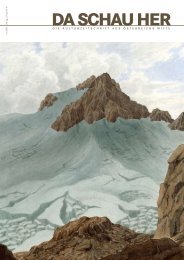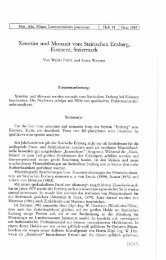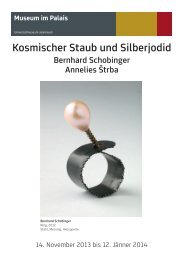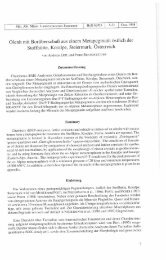Katalog/Catalogue - deutsch/englisch
Katalog/Catalogue - deutsch/englisch
Katalog/Catalogue - deutsch/englisch
Erfolgreiche ePaper selbst erstellen
Machen Sie aus Ihren PDF Publikationen ein blätterbares Flipbook mit unserer einzigartigen Google optimierten e-Paper Software.
wird. Die anderen, die nicht fotografiert werden wollten, wanderten<br />
weiter nach Nordamerika.<br />
In Japan stellt man ein Foto des Verstorbenen in den Hausaltar.<br />
Ältere Menschen beten vor dem Foto für die Toten. Meine Großmutter<br />
hat oft das Foto ihres verstorbenen Mannes angesprochen<br />
und mit ihm geredet. Dabei verkörpert das Foto selbst nicht die<br />
Seele des Toten, sondern das Foto ist ein Sprachrohr, durch das<br />
man mit den Toten sprechen kann.<br />
Ich hatte früher geglaubt, dass sich die Wurzeln für die Vorliebe<br />
der Japaner für den Schnappschuss schon in der älteren Kultur<br />
finden ließen. Matsuo Bashos Haiku-Dichtung könnte zum Beispiel<br />
ein Vorbild für fotografische Momentaufnahmen der Reisenden<br />
sein. Aber neulich bei einer genaueren Lektüre musste ich<br />
feststellen, dass man sich seine Dichtung nicht als Fotografie vorstellen<br />
kann.<br />
Samidare no Vom großen Regen<br />
furinokoshite ya bleibt sie nun doch wohl verschont,<br />
hikaridoo die Goldglanz-Halle!?<br />
Es geht hier in erster Linie nicht um den Glanz der goldenen<br />
Halle, sondern um den Regen, der nicht auf die Halle fiel. Wenn<br />
es in der Grammatik der Fotografie einen Konjunktiv II gäbe,<br />
würde man so etwas aufnehmen können.<br />
Oder:<br />
Nomi shirami Nichts als Flöhe und Läuse!<br />
uma no shito suru Und nah an meinem Kopfkissen<br />
makura-moto pisst auch noch ein Pferd!<br />
Die Insekten im Dunkeln sind schwer zu fotografieren, und der<br />
Piss ist wahrscheinlich in dem Fall nur akustisch wahrnehmbar.<br />
Man könnte sicher die Atmosphäre der Scheune, in der der<br />
Reisende übernachtet, fotografieren. Es geht mir nicht darum<br />
zu beweisen, was man alles nicht fotografisch darstellen kann.<br />
Vielmehr geht es mir darum zu zeigen, dass die Intensität im<br />
Gedicht von der Sprache selbst kommt. „Nomi“ und „Shirami“<br />
enden beide auf „mi“. Auf einem Bild werden der Fuß eines Flohs<br />
und der einer Laus unterschiedliche Formen haben, so dass es<br />
keinen Versfuß mehr gibt.<br />
Bei der Haiku-Dichtung hege ich die Hoffnung, sich von den<br />
Metaphern befreien zu können. Das ist auch der Grund, warum<br />
Yoko Tawada 94 95<br />
turned south and finished up in what is now Japan.<br />
The rest, who did not want to be photographed, went<br />
on towards North America.<br />
In Japan, a photo of the deceased is placed on the<br />
house altar. Older people pray for the dead in front of<br />
the photo. My grandmother often spoke to the photo<br />
of her late husband and talked to him. In this case, the<br />
photo itself doesn’t contain the soul of the deceased.<br />
It’s a voice trumpet for speaking to the dead.<br />
Once I used to believe that the Japanese love of snapshots<br />
was rooted in older culture. For example, Matsuo<br />
Basho’s haiku poetry could be a model for a traveller’s<br />
photographic snapshot. But when I recently looked more<br />
closely, I had to accept that you couldn’t imagine his<br />
poem as photography.<br />
Samidare no The great cloud of rain<br />
furinokoshite ya moves on, and quite passes by<br />
hikaridoo the bright golden hall!?<br />
The first line here is not about the gleaming gold of the<br />
hall but the rain that did not fall on it. If the grammar of<br />
photography had a second subjunctive, you could take<br />
a picture of something like that.<br />
Or again:<br />
Nomi shirami All flea-y, lousy!<br />
uma no shito suru And right beside my pillow<br />
makura-moto packhorses pissing!<br />
Insects are difficult to photograph, and piss is probably<br />
only acoustically perceptible in this case. I’m sure<br />
you could photograph the atmosphere of the barn the<br />
traveller is spending the night in. I’m not out to prove<br />
what you can and can’t photograph, only to show that<br />
the intensity in the poem comes from language itself.<br />
“Nomi” and “Shirami” both end in “-mi”. In a picture,<br />
a flea foot and a louse foot would look different, so that<br />
the metrical foot wouldn’t scan.<br />
In haiku poetry I cherish the hope of shaking off metaphor.<br />
That’s also the reason why I love snapshots. If you<br />
want to represent a flower meaningfully, you ask what



